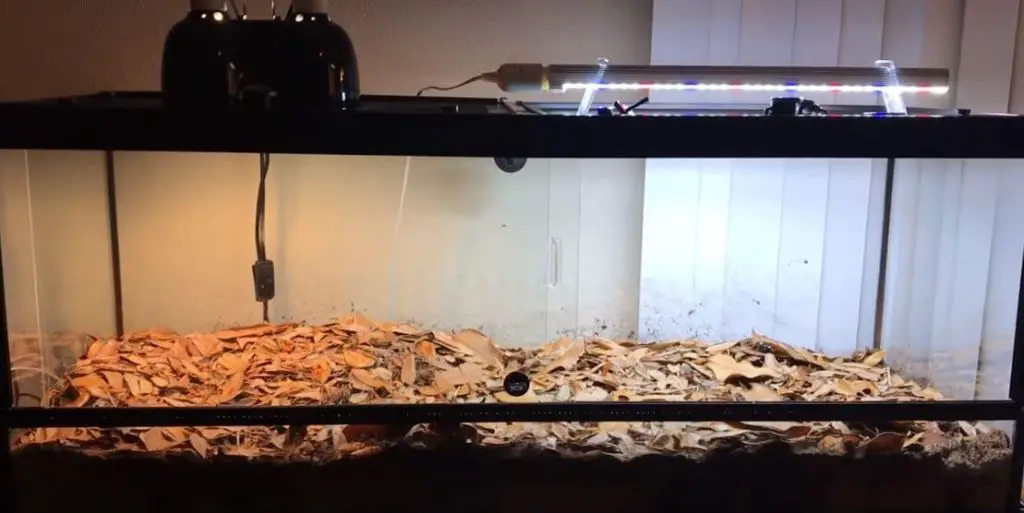Preparing a comfortable and good accommodation for your bearded dragon is very important so choosing the best substrate for bearded dragons or bedding, the material put on the floor surface, will have direct positive influences on the health and enrichment of your lizard.
This is because they could help prevent impaction, disease, and other things that can harm your pet.
There are many opinions about choosing the best flooring for bearded dragons such as loose or solid, flat or uneven, and so on.
While loose bedding is recommended as it allows the lizard to burrow into, flat surfaces like reptile mats are said to be better, and each type always has advantages and disadvantages.
If you are looking for best bearded dragon substrate, don’t hesitate to check out our reviews to get the best choice for your pet.
The Top-Rated Substrate for Bearded Dragons (Recommendations)
#1. ZILLA REPTILE TERRARIUM BEDDING SUBSTRATE LINER – BEST SUBSTRATE LINER
#2. HAMILEDYI REPTILE CARPET, NATURAL COCONUT FIBER CARPET – BEST COCONUT MAT
#3. EXO TERA DESERT SAND BLACK – BEST SAND
#4. ZOO MED REPTIFRESH ODOR-ELIMINATING – BEST EXCAVATOR CLAY
#5. ZOO MED ECO EARTH LOOSE COCONUT FIBER – BEST FIBER SUBSTRATE
#6. ZOOMED ECO CAGE CARPET FOR 55 GALLON TANKS, 13”X48”
#7. ZOO MED ECO CARPET REPTILE CARPET
#8. ZOO MED EXCAVATOR CLAY BURROWING
#9. ZILLA GROUND ENGLISH WALNUT SHELLS DESERT BLEND
#10. ZOO MED FOREST FLOOR BEDDING
#11. ZOO MED REPTI BARK
Related:
- Best Basking Rock For Bearded Dragon
- Plants For Bearded Dragon Cage
- How Big Can a Beardie Get?
- Why Is My Beardie Bobbing His Head?
- Why is My Beardie Hissing at Me?
- Can Beardies Get High?
Guide for Bearded Dragon Substrates
1. Reptile Mats and Terrarium Liners
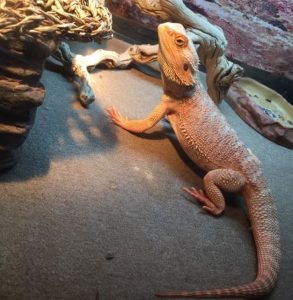
Pros:
- You will find it easy to clean and replace as reptile mats and terrarium liners don’t create dust.
- Maybe you will be afraid that your beardie will eat some pieces of them, which leads to many dangerous results but don’t worry because they are not edible.
- Also, many terrarium liners are safe for both juveniles and adults.
Cons:
- On the other hand, there are some drawbacks to this kind of product.
- You should have your dragon’s nails trimmed to stop them from getting caught on the surface.
- Secondly, two liners are recommended to be purchased because you’ll want a clean, dry one to place in the cage while the dirty one dries.
2. How to Decorate with Substrate for Bearded Dragon
When decorating a cage, it is really important to create an environment mimicking your pet’s natural habitat.
A comfortable environment should have some standards such as abundant space for your beardie to move around and places to hide and rest.
Therefore, to prepare great accommodations like this for your pet, the substrate plays an important role in this process.
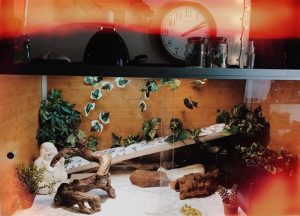
Some Simple Tips For Decorating Your Bearded Dragon Tank:
Regarding the size of the tank, we recommend that a tank at least 20 gallons is suitable for juveniles and a tank at least 1.5 to 2 feet long is for adults.
To keep the bottom of your beardie tank fresh, you should cover it with an inch of a substrate and scoop it every few days.
Bearded dragons always love pampering themselves under the sunlight so you should place a basking lamp at one end of the cage as well as a rock or something for your beardie to rest on and enjoy the warmth.
You also should arrange a place for your dragon to hide.
The opposite end of the tank should be kept a little cooler.
The temperature of the daytime of your beardie tank should be around 85°F with a basking temperature of 100°F to 105°F.
At night, you should reduce the temperature to 75°.
Remember to provide your pet with as much space as you can.
In case you want a comfortable tank, you should purchase a tank that will be large enough for an adult beardie and let your baby beardie grow into it.
3. Loose bedding
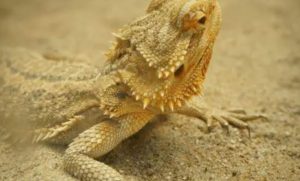
We would like to offer you some necessary information about loose bedding which is only for adults.
Before we get into detail, please join us to discuss the impaction.
Impaction?
Impaction happens when there is a blockage in the intestines of your beardie as he devours too much of the loose substrate that he cannot digest, which could kill your dragon.
Another reason for this is when the beardie is dehydrated and doesn’t have a high enough temperature for basking.
Besides, having a lot of parasites can also make your beardie suffer from impaction as well.
How to Avoid Impaction?
You can take some steps to tackle this problem by providing enough drinking water and placing his food in a dish, not on top of the substrate.
Secondly, you should choose the best bearded dragon bedding that can mimic his natural environment in the wild.
And last but not least, make sure that you give him enough calcium with his food to prevent him from eating the substrate.
Best Substrate For Bearded Dragons Shortlist (Updated List)
*Ratings are from Amazon at the time of publication and can change
The Best Bearded Dragon Substrates
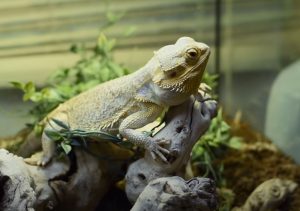
#1. ZILLA REPTILE TERRARIUM BEDDING SUBSTRATE LINER – BEST SUBSTRATE LINER

There is a variety of colors and sizes of Zilla’s terrarium liners you can freely take one you like.
Especially, unlike walnut shells or sand, a terrarium liner is unedible so it would be suitable for both juvenile and adult beardie.
Additionally, this product is so friendly to the environment as it’s made from recycled materials, which allows you to reuse it.
You also find it easy to clean or tidy as you just need to shake off dried poop and leftover food, then rinse the liner with cold water.
For the best results, we recommend that you should buy two liners so that you can flexibly use a clean one in the aquarium and wash the other.
Many of you will be afraid of odor but don’t worry as Zilla says that it’s treated with biodegradable enzymes to reduce smells.
Especially, with the high quality of materials, Zilla’s terrarium liners are completely nonabrasive and absorbent.
However, in case your dragon’s nails are long, this can make your beardie get caught on the substrate for bearded dragons so pet owners should trim your dragon’s nails.
Pros:
- Easily be cut to fit the size of the cage
- NO get caught or be ingested
- Soft and non-abrasive materials
Cons:
- Doesn’t deal with heat well and may absorb liquid
#2. HAMILEDYI REPTILE CARPET, NATURAL COCONUT FIBER CARPET – BEST COCONUT MAT

This is also a good option when choosing the right substrate for bearded dragons due to the non-abrasive coconut fiber carpet, and you can easily trim it to fit the enclosure.
Especially, it can help reduce odor or smell with a biodegradable enzyme.
To make it clear, you can use cold water to wash it.
#3. EXO TERA DESERT SAND BLACK – BEST SAND

Another option for your beardie is this Exo Tera Desert Sand. Due to its deep black color, it will give your tank a unique appearance.
This product is good at holding heat and has a homogenous grain size, which encourages natural burrowing behaviors.
Especially, this product is examined to remove any contaminants and you will find it easy to clean.
Pros:
- Provide a natural-looking desert home
- A great conductor of heat
- Encourages burrowing behavior
Cons:
- Baby beardie may accidentally ingest it
#4. ZOO MED REPTIFRESH ODOR-ELIMINATING – BEST EXCAVATOR CLAY

This kind of substrate for bearded dragons can last up to a year before you need to replace it.
You can mix it with Zoo Med’s Excavator clay or ReptiSand clumps if you can scoop out messes.
It provides calcium so that your dragon won’t need to consume the bedding.
#5. ZOO MED ECO EARTH LOOSE COCONUT FIBER – BEST FIBER SUBSTRATE

Pros:
- Give moisture and a safe environment
- Break down waste
- Carefully processed natural coconut fiber, with no chemicals
- Great simulating tropical environments
#6. ZOOMED ECO CAGE CARPET FOR 55 GALLON TANKS, 13”X48”

To prevent your dragon’s nails from snagging on the surface, you should trim these nails.
But you have to make sure that your beardie will ingest the post-consumer recycled plastic.
Pro
- Washable reptile carpet
- Won’t irritate your beardie’s scales
#7. ZOO MED ECO CARPET REPTILE CARPET

A reptile cage carpet will surprise you when suing as.
Firstly, it is completely secure for your pet as it does not contain many chemicals and any sharp texture affecting the skin and eyes of reptiles.
Secondly, you can reuse many times, what you need to do is cleaning.
#8. ZOO MED EXCAVATOR CLAY BURROWING

The Excavator Clay is changeable as you add a little water to it and shape terrain for your beardie to enjoy.
However, when it dries, it’s not hard or rough enough to holds its form.
In the case of smelly spots, it is recommended that owners should keep some dry clay handy to replace them.
Because this substrate retains heat so if you have an under tank heater, you shouldn’t use the substrate for bearded dragons.
Pros:
- Stimulate natural burrowing instincts
- 100% natural materials
- Easy to clean or replace
Cons:
- Not safe if accidentally ingested
#9. ZILLA GROUND ENGLISH WALNUT SHELLS DESERT BLEND

Ground English Walnut shells are produced in tiny rounded and uniform pieces, which allows your beardie to dig as the shells, unlike sand, don’t stick to the reptile’s body.
Additionally, no strong odor can be found in this bedding and you don’t have to worry about a lot of dust.
However, you have to make sure not to use this type of substrate for hatchlings or juveniles.
Pros:
- Soft and fine texture.
- Friendly natural materials, harmless and non-toxic
- Realistic-looking desert environment
Cons:
- No retain heat like sand
- Can accidentally be ingested
#10. ZOO MED FOREST FLOOR BEDDING

Pros:
- Provide natural habitat like the jungle environment for your pet
- It is good at holding moisture and absorbency
- The soft texture is safe for reptiles
- Natural cypress is completely free of harmful chemicals.
#11. ZOO MED REPTI BARK

Of all the best substrate for bearded dragons, this substrate can conduct and distribute heat more evenly.
Additionally, it provides stimulating features to your reptile’s environment so your dragon can freely dig and burrow in it as if they were in the wild.
Besides, small pieces are interlocking, which helps prevent live food in the terrarium from setting up home in the substrate.
However, it is highly absorptive so you have to keep everything clean and dry.
Every two or three months, remove it and soak it in hot water to refresh it and you can even reuse it.
Especially, you will find it economical as you will only need to replace it once a year.
Pros:
- Fir tree bark
- Stimulating environment
- Reused for up to a year
- Produces a humid environment
Commonly Asked Question About Bearded Dragons Substrates
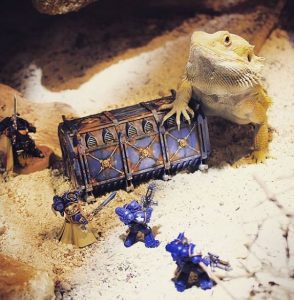
1. What is The Best Bearded Dragon Bedding?
Paper towels, newspaper, or butcher paper would be the best bedding for hatching or juvenile as they are safe and cheap. Otherwise, you can choose one of the reptile mats we reviewed at the beginning of the article.
On the other hand, you can use loose bedding for an adult dragon.
Despite the dust, fine quartz sand may be the best bearded dragon bedding as It mimics their natural habitat.
One compulsory thing that you have to remember is providing adequate calcium in diet and water to drink, which is the way to protect your pet.
Also, a warm spot is always available for your dragon to sun himself, and when feeding him, you have to put the food in a dish.
In case of emergency, you should ask your vet for recommendations before deciding on anything as she or he has specialized experience in treating impaction in reptiles.
2. What About Calcium-Based Sand?
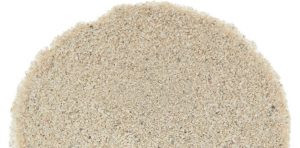
The reason for the idea of calcium-based sand arose from the fact that your beardie may eat some, which leads to the impaction for your pet.
Therefore, due to this product, in case your beardie intake some, they will just get a harmless calcium supplement as the sand breaks down in their digestive system.
Choosing calcium-based sand is also a good idea to provide a substantial surface of the cage that is not sand.
And you can easily find many of these sands available at your local pet store and online.
However, there are some circumstances that some keepers still find that their dragons are more likely to eat calcium-based sand as it tends to be slightly finer and therefore easier to ingest than coarser natural sands.
This may have some negative impacts on your beardie so you should keep an eye on him carefully and make sure he isn’t eating too much of the sand or eating it behaviorally.
Related:
- Can Beardies Eat Peas?
- Can Beardies Eat Squash?
- Do Beardies Eat Brussel Sprouts?
- Can Beardies Eat Honeydew Melon?
- Can Beardies Eat Radish Greens?
- Do Beardies Eat Dill?
- Can Beardies Eat Rosemary?
- Can Beardies Eat Chard?
3. Is Coconut Substrate Good for Bearded Dragons?
Coconut Fiber & Sand for beardies includes sand and coconut fiber in your dragon’s cage, which makes these substrates equivalent to his natural habitat and helps him a comfortable environment.
4. Should Choose Bearded Dragon Sand or Wood Chips?
To stop beardie from eating bedding made of small particles, you should not use sand (including biodegradable calcium-based sands), wood chips, or gravel. You had better use newspaper, paper towels, or reptile carpet.
5. Why is Sand Bad for Bearded Dragons?
Commonly, people use sand as a substrate for bearded dragons.
However in case young lizards est some by accident, they will face intestinal impaction.
Therefore, regarding young beardie, you shouldn’t keep them on the sand, or any kind of loose substrate.
6. What Can I Use Instead of Sand for My Bearded Dragon?
Instead of using sand, you can check out several different substrates below that you can use in your bearded dragon enclosure.
Sand and Similar Materials. In the wild, beardie spends their entire life running across sands and pebbles. …
- Newspaper.
- Ceramic Tiles.
- Reptile Carpets.
- Bark and Mulch.
7. Can I Put Tile in My Bearded Dragon Tank?
Of course, tile or other materials like slate, linoleum, or ceramic are widely used for the bearded dragon substrate. …
However, you should provide your dragon with plenty of other things to climb around so they’re not always on the tile
8. What’s The Best Substrate for Baby Bearded Dragons?
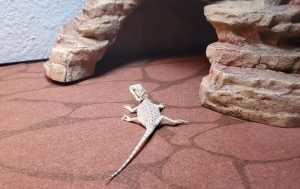
Regarding babies, the best substrate for bearded dragons is newspaper or towels.
Until they are at least turn 5 months old, you can use sand.
You should choose the best sand for bearded dragons that are not silica (sharp), coarse or unwashed when setting up a dragon’s terrarium.
Read more:
- Best Substrate For Chameleons – Complete Guide
- Top 7 Best Bearded Dragon Starter Kit: For Easy Setting up
- Best Substrate For Russian Tortoise
Conclusion
We cannot deny that beardies are such an amazing pet and giving your pet a comfortable natural habitat is important.
Therefore, you have to be careful to choose the best substrate for bearded dragons, which will help you provide them with their environment close to their natural habitat and keep them safe and warm.
Especially, regarding baby and juvenile dragons that are vulnerable, you have to choose the right loose substrate for bearded dragons.
One dangerous problem that you may face is that your pet will ingest some materials like sand and rocks so make sure you watch your pet carefully.
One solution is choosing a style of substrate that is inedible to limit the possibility of this issue altogether.
Further Reading:
- How is the quality of Carolina Custom Cages Terrarium?
- Accessories For Beardie
- Best Substrate For Leopard Gecko
- Best Beardie Leash And Harness Reviews
- Fancy BD vs Bearded Dragon – Which one is the best?
- B.D VS Chameleon – Facts And Differences
- BD Vs Horned Toad – Facts And Differences
- Dunner B.D Vs Normal Beardie: Facts And Differences
- How To Tell If Your BD Likes Music? You Don’t know?

